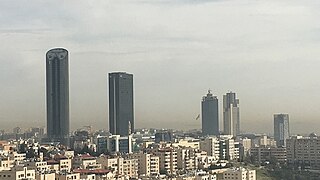
Amman is the capital and the largest city of Jordan, and the country's economic, political, and cultural center. With a population of 4,061,150 as of 2021, Amman is Jordan's primate city and is the largest city in the Levant region, the fifth-largest city in the Arab world, and the tenth-largest metropolitan area in the Middle East.

Petra, originally known to its inhabitants as Raqmu or Raqēmō, is a historic and archaeological city in southern Jordan. Famous for its rock-cut architecture and water conduit system, Petra is also called the "Rose City" because of the colour of the sandstone from which it is carved; it was called "a rose-red city half as old as time" in a poem of 1845 by John Burgon. It is adjacent to the mountain of Jabal Al-Madbah, in a basin surrounded by mountains forming the eastern flank of the Arabah valley running from the Dead Sea to the Gulf of Aqaba. Access to the city is through a picturesque 1.2-kilometre-long gorge called the Siq, which leads directly to the Khazneh.

The history of Jordan refers to the history of the Hashemite Kingdom of Jordan and the background period of the Emirate of Transjordan under British protectorate as well as the general history of the region of Transjordan.

A nymphaeum or nymphaion, in ancient Greece and Rome, was a monument consecrated to the nymphs, especially those of springs.

Zarqa Governorate is the third largest governorate in Jordan by population. The capital of Zarqa governorate is Zarqa City, which is the largest city in the governorate. It is located 25 kilometres (16 mi) east of the Jordanian capital Amman. The second largest city in the governorate is Russeifa.

Karak is one of the governorates of Jordan, located south-west of Amman, Jordan's capital. Its capital is Al-Karak. It s bordered by Madaba and the Capital governorates to the north, Ma'an Governorate to the east, Tafilah Governorate to the south, and the Dead Sea to the west.

Hussein bin Abdullah is Crown Prince of Jordan as the eldest son of King Abdullah II and Queen Rania. He is a member of the Hashemite dynasty, the royal family of Jordan since 1921, and is considered to be 42nd-generation direct descendant of the Islamic prophet Muhammad.
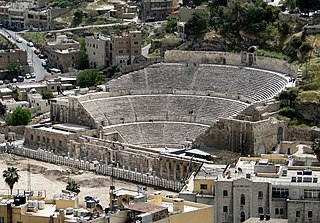
Roman Theatre of Amman is a 6,000-seat, 2nd-century Roman theatre. A famous landmark in the Jordanian capital, it dates back to the Roman period when the city was known as Philadelphia. The theatre and the nearby Odeon are flanking the new Hashemite Plaza from the south and the east respectively, while the Roman Nymphaeum is just a short stroll away in north-westerly direction.
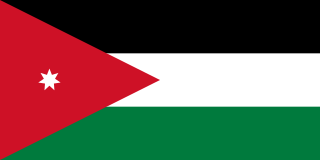
Jordan, officially the Hashemite Kingdom of Jordan, is a country in the Southern Levant region of West Asia. Jordan is bordered by Syria to the north, Iraq to the east, Saudi Arabia to the south, and the occupied Palestinian territory of the West Bank and Israel to the west. The Jordan River, flowing into the Dead Sea, is located along the country's western border. Jordan has a small coastline along the Red Sea in its southwest, separated by the Gulf of Aqaba from Egypt. Amman is Jordan's capital and largest city, as well as the most populous city in the Levant.
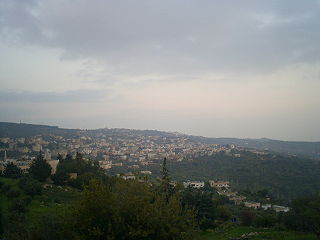
Mahis is a town in the Balqa Governorate northwest from the governorate's capital Salt, and 10 kilometers (6.2 mi) west of Amman. Its population was 17,754 in 2015. Most of the population of Mahis descends from the Abbadi tribe.. The mountainous town is located at over 800 meters (2,600 ft), with views on the Jordan Valley, West Bank with Jerusalem's walls visible on the horizon. Mahis is known for its orchards and its numerous water fountains and springs, notably the Fountain of Mahis.
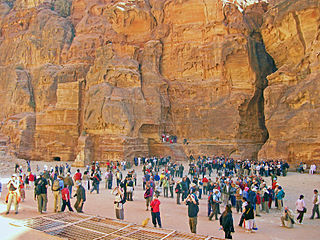
Jordan is a sovereign Arab state in the Middle East. The capital, Amman, is Jordan's most populous city as well as the country's economic, political and cultural centre.

Jordanian art has a very ancient history. Some of the earliest figurines, found at Aïn Ghazal, near Amman, have been dated to the Neolithic period. A distinct Jordanian aesthetic in art and architecture emerged as part of a broader Islamic art tradition which flourished from the 7th-century. Traditional art and craft is vested in material culture including mosaics, ceramics, weaving, silver work, music, glass-blowing and calligraphy. The rise of colonialism in North Africa and the Middle East, led to a dilution of traditional aesthetics. In the early 20th-century, following the creation of the independent nation of Jordan, a contemporary Jordanian art movement emerged and began to search for a distinctly Jordanian art aesthetic that combined both tradition and contemporary art forms.

The Amman Citadel is an archeological site at the center of downtown Amman, the capital of Jordan. The L-shaped hill is one of the seven hills (jebal) that originally made up Amman.

Downtown Amman is an old, central commercial area of Amman, Jordan.
The following is a timeline of the history of the city of Amman, Kingdom of Jordan.
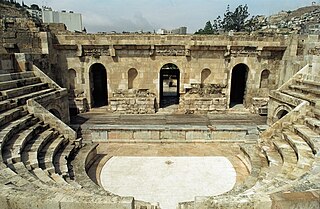
The Odeon is a small 500-seat theatre in Amman, Jordan. Not to be confused with the large Roman Theatre that stands right next to it, on the southern side of the Hashemite Plaza, while the Odeon stands on the east side of the Plaza.
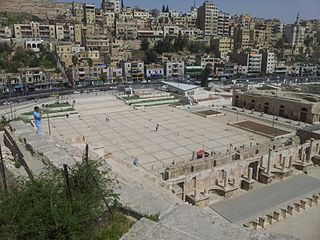
The Hashemite Plaza is a plaza in Amman, Jordan that spans over an area of 20,000 square metres. It was renewed in 2014 and is named after the Jordanian royal family, the Hashemites.

Mona Saudi was a Jordanian sculptor, publisher, and art activist.

The Jordan Museum is located in Ras al-Ein district of Amman, Jordan. Built in 2014, the museum is the largest museum in Jordan and hosts some of the country's most important archaeological findings. Its two main permanent exhibitions are the Dead Sea Scrolls, including the Copper Scroll, and the 9000-year-old ʿAin Ghazal statues, which are among the oldest human statues ever made.
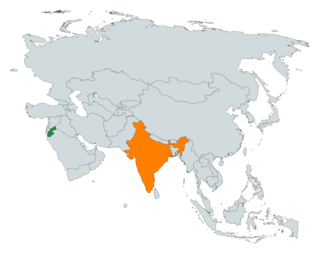
The Republic of India and the Hashemite Kingdom of Jordan signed their first bilateral agreement for cooperation and friendly relations in 1947. The agreement was formalized in 1950, when India became a republic, and full diplomatic relations were established between the two countries.





















